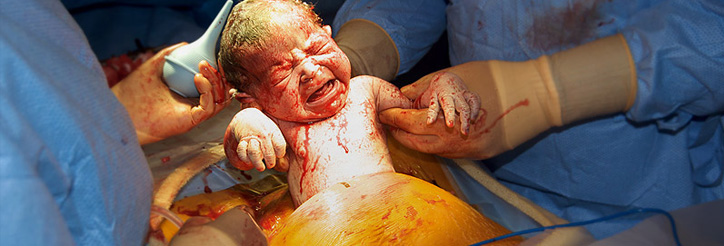Caesarean Delivery
In some cases, your doctor will recommend a c-section instead of a vaginal delivery. No matter what type of birth you're planning (and hoping) for, you shouldn't rule out the possibility of a Cesarean section.

But C-sections can help women who are at risk for complications avoid dangerous delivery-room situations and can be a lifesaver in an emergency. C-sections are done by obstetricians (doctors who care for pregnant women before, during, and after birth) and some family physicians. Although more and more women are choosing midwives to deliver their babies, midwives of any licensing degree cannot perform C-sections.
Why Are C-Sections Needed?
Some C-sections are scheduled if the doctor knows that a vaginal birth would be risky. A doctor may schedule one if:
- the baby is in breech (feet- or bottom-first) or transverse (sideways) position in the womb (although some babies can be turned before labor begins or delivered vaginally using special techniques)
- the baby has certain birth defects (such as severe hydrocephalus)
- the mother has problems with the placenta, such as placenta previa (when the placenta sits too low in the uterus and covers the cervix)
- the mother has a medical condition that could make a vaginal delivery risky for herself or the baby (such as HIV or an active case of genital herpes)
- some multiple pregnancies
- the mother previously had surgery on her uterus or an earlier C-section
Your labor coach, wearing a surgical mask and gown, can be right by your side during the entire delivery (although partners might not be allowed to stay during emergency C-sections). Before the procedure begins, an anesthesiologist will discuss what will be done so that you don't feel pain during the C-section.
You won't feel any pain during the C-section, although you may feel sensations like pulling and pressure. Most women are awake and simply numbed from the waist down using regional anesthesia (an epidural and/or a spinal block) during a C-section.
That way, they are awake to see and hear their baby being born. A curtain will be over your abdomen during the surgery, but you may be able to take a peek as your baby is being delivered from your belly.
Sometimes, a woman who needs an emergency C-section might require general anesthesia, so she'll be unconscious (or "asleep") during the delivery and won't remember anything or feel any pain.
As with any surgery, there's usually some degree of pain and discomfort after a C-section. The recovery period is also a little longer than for vaginal births. Women who've had C-sections usually stay in the hospital for about 3 or 4 days.